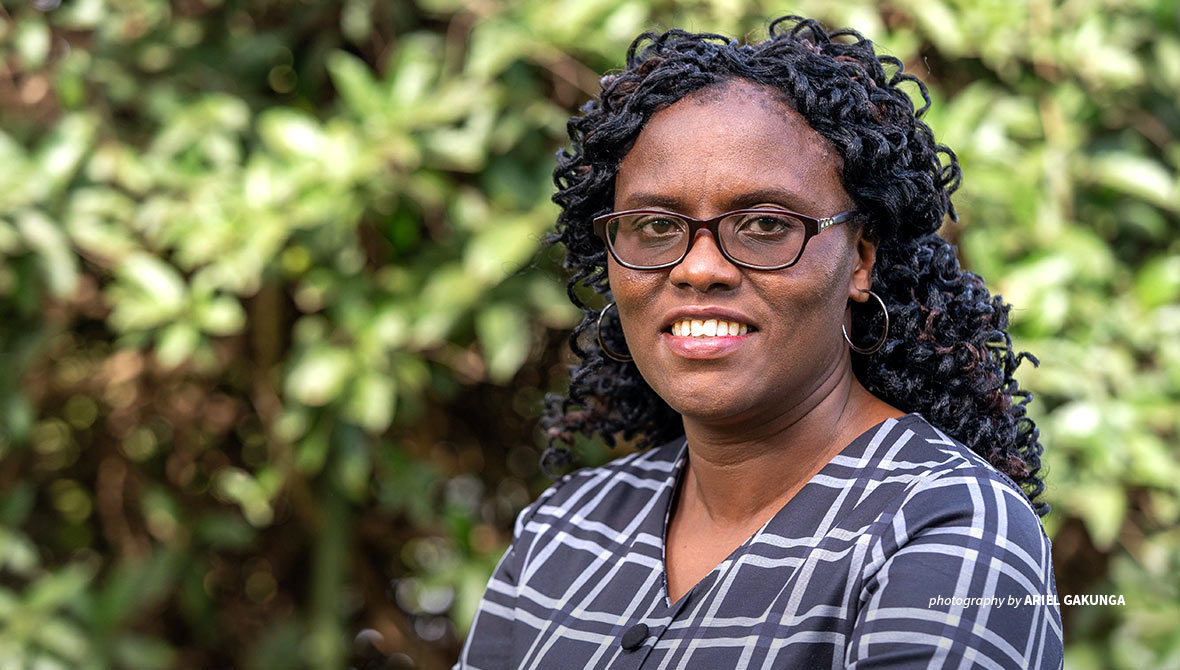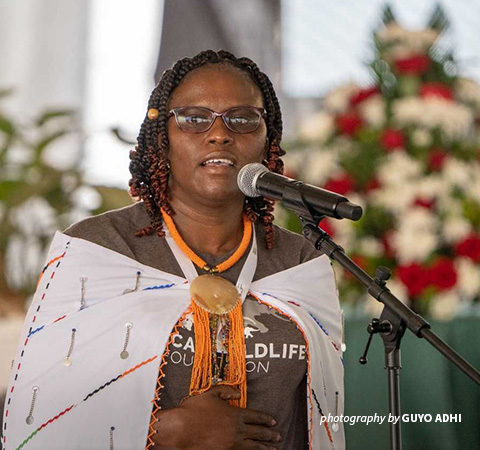Women, water, and wildlife: What connects us all?

African Wildlife Foundation Country Director, Kenya Nancy Githaiga
Tasked with fetching water every morning as a young girl, African Wildlife Foundation’s Nancy Githaiga learnt that water access shapes women’s lives as providers of sustenance. Growing up in Kaheho village in Molo, roughly 200 kilometers from Kenya’s capital, she vowed to improve water infrastructure for her village and others across the country. Instead of becoming a civil engineer, she pursued hydrology after an undergraduate degree in mathematics and physics, and furthered her studies in climate change.
Improving water access is still her life purpose, but her experiences in the wildlife conservation sector expanded her view. “I feel at home now,” she says, nearly eight months since joining AWF as Country Director, Kenya. On International Women’s Day, she reflects on why realizing her childhood dream is more important than ever.
How are women connected to water?
In Kaheho, Molo, our biggest challenge was the issue of finding safe potable water. Especially during the school holidays, every day at dawn would mean trekking to a stream or a spring. Sometimes we had to wait hours for it to recharge if someone else got there first — nothing traumatised me more than the thought that we would do this endlessly. There is no African who can speak about water without speaking about women; we have always been the ones who know where water will be found, we will be the ones walking the long trips. So when water resources become scarce, women’s futures are impacted directly.
In my village today, women and young girls still have to walk kilometers to fetch water; they have to queue up and wait for the springs to recharge, just as we did. And with more people in the village now, I wonder how people are coping. Through my training and my experiences working on community-based natural resource management, it is clear that climate change is creating more complex challenges for women. Over the years, my view of water access has also expanded — it is not just about drilling boreholes and putting water in the tap, but it is also about managing the catchments where this water comes from.
How does water conservation benefit wildlife and people?
Water is not found in isolation; it is part of the natural ecosystem, and therefore, part of the wildlife habitat. Wildlife conservation is essentially about habitats, it is about forest and water conservation. Being a shared resource, water links wildlife and the communities that live in these spaces. In large landscapes like Tsavo, we have seen high incidences of human-wildlife conflict as people, livestock, and wild animals all struggle for the minimal water available. The Kenya government recently reported that the country lost 62 elephants between August and December 2021 due to the prolonged drought, with most deaths recorded in Tsavo. This is higher than the loss from illegal wildlife trade. The landscape was strewn with wildlife carcasses, not because the animals cannot walk long distances in search of pasture, but for lack of water.
By providing a platform for communities to engage in the management and governance of natural resources, we are securing a future for wildlife as well. Additionally, we increase the opportunities for people to share benefits from wildlife conservation, for instance, by way of setting aside community land for conservancies. People can also earn incomes from activities that do not degrade the ecosystem, such as climate-smart agriculture or tourism-based microenterprises.

Nancy Githaiga, AWF Country Director, Kenya, at the Tembo Naming Festival
What challenges do women in conservation face?
At the community level, the establishment of conservancies has created opportunities while also safeguarding wildlife corridors and connecting protected areas, but rural women may not be able to reap the benefits because they are not the recognized owners of the land. At the same time, few women engage at the governance level of conservancies — these spaces are historically male-dominated but women are also challenged by their household responsibilities. She might ask herself, “If I’m struggling to take care of my family’s basic needs, how can I begin to take on issues within the community?”
The same dynamic plays out in the professional field of conservation — we are still seeing less women in this space. It is not that there are no women scientists or that we cannot do the work, but the environment is not enabling. For instance, were I posted in a remote conservation area and had to move with my family, I would have to think about where my children will go to school and where they will get medical attention. We are always thinking about tomorrow — that is why biodiversity protection needs more women in decision-making positions. We think long-term, we think the future and so we make strategic changes that last longer.
It is high time for us to make a deliberate effort to include marginalized groups — especially now as we rethink conservation models in the aftermath of the COVID-19 pandemic and as we continue to adapt to mounting climate risks. For example, the Classroom Africa program is identifying rural schoolchildren in the Tsavo landscape and preparing them to apply for scholarships so they have access to the same opportunities as their urban counterparts. Ultimately, young students that share space with wildlife are best placed to engage in conservation.
What excites you about your role as AWF Country Director, Kenya?
Joining AWF as the organization was developing its new 10-year strategic vision has been very exciting. We are also in the midst of a global pandemic and therefore an opportunity to rethink our models and solutions. It is a big challenge but also presents a big opportunity to change how conservation is done in the coming years. We might not have all the answers yet, but our multidimensional approach considers science, socioeconomics, development, and the private sector so we can venture into new areas. It is not a choice between development and conservation but a country where development and conservation go hand in hand, where wildlife and wildlands thrive in a modern Kenya.
AWF’s efforts to engage leadership — whether in the political or technical arena and even in the youth sector — are so important and impactful. For nature-based economies like Kenya, we need sustainable solutions and leaders who understand that progress depends on our forests, rivers, and rangelands. When I run for political office one day, I will stay true to my calling — water. I know first-hand that being water-poor is the greatest poverty that any person can face and as a conservationist, I know that water supports all species in our essential ecosystems. Ensuring that water flows will mean catchments thrive and wildlife thrives too, and this gives us a balanced system that can sustain our developmental needs.